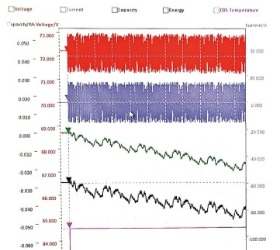


As part of
troubleshooting and the development of battery technology, the analysis and
testing of entire battery packs, serials and single cells is absolutely
necessary.
The
measurement of the capacity of a battery is not easy thing and certainly cannot
be measured directly, e.g. the voltage in volts or the current flow in amperes.
In order to determine the capacity of a battery in Ah or Wh, it has to be discharged
and recharged in a process of numerous charging and discharging cycles. The
currents and voltages that occur are measured, documented and evaluated.
At the end
of this measurement process, the result is the value of the battery capacity
determined under the current circumstances.
In our
in-house technology department, we analyze and test lead and lithium batteries
from 0 - 100V with a discharge current of up to 60A.
The test is possible on up to 8 batteries at the same time. The test technology required for this, of which there are only a handful of devices in Germany, comes from one of the market leaders in this segment.
Values that are checked, measured & analyzed and documented are:
• Battery voltage
• Battery capacity
• Cell temperatures
• Cell voltage
• Internal resistances
• BMS analytics & valuation
• (if available) reading out, analysis & evaluation of so-called "lifetime values" of the memory chips in relation to historical values such as last charging processes, charging start voltage & end voltage, number of charging cycles, date, times etc.
All values
are documented to the second and are included in the test certificate at the
end of the test cycle to determine the test result.
During the
test cycle, the battery is actively protected against voltage peaks, current
peaks, over and deep discharge, incorrect voltages and fault currents.
In order to
obtain values that are as realistic as possible, we measure using different
scenarios - also to be able to rule out measurement errors.
On the one
hand, measurements of single cycles as well as multiple cycles are measured. For
example, a battery runs through a total of 5 full charging cycles, from which
an average value is then calculated in order to exclude all tolerances and
measurement peaks.
Furthermore,
we can test batteries using individually determined route profiles and driving
scenarios as in real use. I.e. depending on body weight (payload), route
topography (incline and descent), outside temperature and speed, we select the
most suitable from a variety of stored profiles and use it to measure the
battery to be tested. The measurement result thus coincides with reality to an
extremely high percentage. At the same time, the battery is measured with a
standard profile, which gives us extremely comparable and, above all,
meaningful values.
The test
duration of a battery strongly depends on its capacity and the amount of
charging current, but is always from a few hours to several days.



